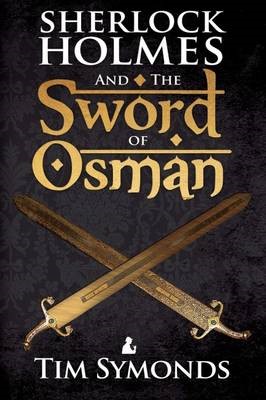Book Review: Tim Symonds: Sherlock Holmes and the Sword of Osman

It is rare that I pick up a Holmes pastiche and immediately fall in love with it – but it happened with this book. Symonds managed to catch the voice of early retirement Watson so perfectly and with so much love and whimsical sarcasm that it is a joy to read from beginning to end. The story itself is set in a time when European powers were slowly realizing that a war unlike any before was approaching. Holmes and Watson come together for an adventure set in 1906 to make sure that the Sword of Osman, an insignia of the emperor of the Ottoman Empire, will remain in the hands of the ruling king in order to keep the brittle stability between several European nations and the Ottoman Empire intact. The initially mysterious client who sends the duo to Istanbul is Sir Edward Grey, Foreign Secretary and a great admirer of both Holmes and Watson.
The adventure is complex, the case more difficult and dangerous than Holmes or Watson anticipate and rife with references to historical and political events – an intertextual feast. I do not want to give away too much of the story, but Symonds manages to write Sherlock Holmes and John Watson very close to how Doyle wrote them and yet manages to make them his own. The story is never boring and there are enough questions and mysteries to keep the reader on edge, especially with some knowledge on the political context (I recommend reading up in the relationship between Britain and the Ottoman Empire at the turn of the century for even greater enjoyment of the book).
Symonds also manages to do what very few pastiches manage: He makes the ending surprising even after Holmes offers us the solution to the mystery. It’s entertaining and educational and offers deeper insight into Holmes’s role in European politics, which results in his role as a double agent in Doyle’s “His Last Bow” as well as his relationship with John Watson and Mycroft Holmes.
It is definitely one of my favourite Holmes pastiches so far, and I am excited to read more of Symonds’s work. I would like to thank Tim Symonds for unexpectedly sending me the book and thereby providing a wonderful reading experience. You can buy the book on Symonds’s website as well as on amazon.co.uk, amazon.com, amazon.de and strandmag.com.
(note: I wrote this review in August 2015, but for some reason we failed to put it up on our website, which I only realised when I wanted to link the review of Symonds’s Sherlock Holmes and the Nine-Dragon Sigil – so here it is; with apologies to the author)

Maria teaches English Literature at Leipzig University, Germany, published a German introduction to Sherlock Holmes and is a fan of all things Holmes – but especially of the Canon stories and Sherlock BBC. Contact her at @stuffasdreams & maria@bakerstreetbabes.com
Dear Maria, what a wonderful review of my ‘Sherlock Holmes And The Sword Of Osman’ – greatly appreciated! I have only just (February 2019) come across the review online! Sword of Osman’ has now also been published in Italian by Mondadoro. My latest book has just come out, ‘A Most Diabolical Plot’, a collection of 6 Sherlock Holmes short stories. Here’s what’s being sent out for some coverage. Please let me know if I may send you a complimentary review copy.
A brand-new collection of Sherlock Holmes short stories by Tim Symonds –
including how with Kismet’s help Watson uncovers a most diabolical plot against his comrade-in-arms…
From MX Publishing (London), six of the most intriguing cases ever to challenge Sherlock Holmes and his faithful biographer Dr. John H. Watson. In each case Holmes displays the brilliant deductive skills expected of Europe’s greatest Consulting Detective but many readers will also have particular admiration for the part Dr. John H. Watson plays. The good doctor is an ideal companion – a man of steadfast nature, an Englishman of the Victorian school whose bravery on the field of battle in a Boys Own Paper Afghanistan or at Holmes’s side is indisputable. Holmes and Watson criss-cross England during those near-fabled days when Queen Victoria sat on the throne of Britain’s immense Empire, followed by her son Edward V11 and in turn her grandson George V. More at http://tim-symonds.co.uk
The title storyof A Most Diabolical Plot involves the dastardly Colonel Moran hiding away on the borders of Suffolk and Essex, plotting a grisly death for his arch-enemy.
The spooky The Ghost Of Dorset House takes place in London’s expensive Mayfair district. Die Weisse Frau finds the pair caught up with horses, spies and Zeppelins in the midst of the Great War in the Wiltshire countryside not far from Stonehenge. The Mystery Of The Missing Artefacts opens with Watson a prisoner of war in the Ottoman Sultan’s Palace but moves quickly to the British Museum and the small village of Battle in deepest Sussex. The Pegasus Affair, a story of treachery and treason, begins after Watson finds an envelope on the hall table at his Marylebone Medical Practice containing a cutting from The Eastbourne Chronicle.
The final story, The Captain In The Duke of Wellington’s Regiment, is set in an East Anglian university town (possibly Cambridge) and around Apsley House, the great Duke of Wellington’s mansion at Hyde Park Corner.
The book is listed on Amazon in the UK at https://www.amazon.co.uk/Most-Diabolical-Plot-Compelling-Sherlock/dp/1787054047 and Amazon USA at https://www.amazon.com/Most-Diabolical-Plot-Compelling-Sherlock/dp/1787054047
Signed copies available from the author at http://tim-symonds.co.uk/shop/a-most-diabolical-plot/
Tim Symonds’ novels include Sherlock Holmes And The Mystery Of Einstein’s Daughter, Sherlock Holmes And The Case Of The Bulgarian Codex, Sherlock Holmes And The Dead Boer At Scotney Castle, Sherlock Holmes And The Sword Of Osman, and Sherlock Holmes And The Nine-Dragon Sigil.
Tim Symonds was born in London. He grew up in Somerset, Dorset and the British Crown Dependency of Guernsey. After several years travelling widely, including farming on the slopes of Mt. Kenya and working on the Zambezi River in Central Africa, he emigrated to the United States. He studied at Göttingen, in Germany, and the University of California, Los Angeles, graduating cum laude and Phi Beta Kappa. He is a Fellow of the Royal Geographical Society.
Excerpt from ‘The Mystery of the Missing Artefacts’
by Tim Symonds
August 1916
A dungeon under the Dolmabahçe Palace, Constantinople
I stared up at the patch of blue sky visible through a tiny grille high up on the wall. I was a prisoner-of-war in Constantinople, left to rot in a dank cell under the magnificent State Rooms of
Sultan Mehmed V Reşâd. My only distraction was a much thumbed copy of Joseph Conrad’s The Secret Agent. Near permanent pangs of hunger endlessly recalled a fine meal I enjoyed with my old friend Sherlock Holmes at London’s famous Grand Cigar Divan restaurant some years earlier. What I would now give for such a repast I reflected unhappily. Every detail came to mind: the Chef walking imposingly alongside the lesser mortal propelling a silver dinner wagon. Holmes ordering slices of beef carved from a large joint, I the smoked salmon, a signature dish of the establishment. For dessert, we decided upon the famous treacle sponge with a dressing of Madagascan vanilla custard. And a Trichinopoly cigar to top it off.
I should explain how twists and turns of fate had brought me to my present state. I shall not go into exhaustive detail. Suffice it to say that at the start of the war against the German Kaiser and his Ottoman ally I volunteered to rejoin my old Regiment. The Army Medical Corps assigned me to the 6th (Poona) Division of the British Indian Army which had captured the town of Kut-al-Amara a hundred miles south of Baghdad, in the heart of Mesopotamia. I had hardly taken up my post when the Sultan retaliated by ordering his troops to besiege us. Five desperate months left us entirely without food or potable water. Our Commanding Officer surrendered. The victors separated British Field Officers from Indian Other Ranks and transported us to various camps across the
Ottoman Empire. I found myself delivered to the very palace where ten years earlier the previous ruler, Sultan Abd-ul-Hamid II, received Sherlock Holmes and me as honoured guests. Now I was confined to a dungeon under the two hundred and eighty five rooms, forty-six halls, six hamams, and sixty-eight toilets of the magnificent building of the Yildiz Palace. It was clear from the despairing cries of my fellow captives that I was to be left in squalor and near-starvation until the Grim Reaper came to take me to a Life Beyond.
The heavy door of my cell swung open. Rather than the surly Turkish warder bringing a once-daily bowl of watery grey soup, a visitor from the outside world stood there. We stared at each other. I judged him to be an American from the three-button jacket with long rolling lapels and shoulders free of padding. The four-button cuffs and military high-waisted effect reflected the influence of the American serviceman’s uniform on civilian fashion.
The visitor spoke first. “Captain Watson M.D., I presume?” he asked cordially. He had a New England accent.